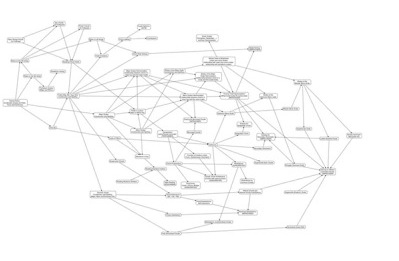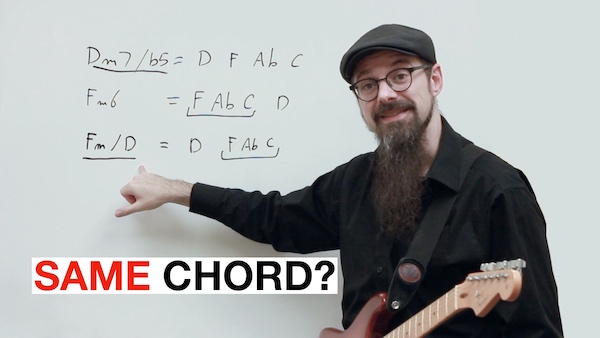What Should You Call THIS CHORD? And WHY?


Have you ever wondered why you might name a chord in one way over another?
Technically speaking, there are multiple names that could be given to any chord there is so is there some kind of protocol for knowing what name to use?
Simply put, you should use the name that most closely aligns with how smart you want to sound. (1)
Take for example a C major chord, which contains the notes C, E, and G.
If you want to sound like a total nitwit, you could just say "C major".
If you want to sound sophisticated, eloquent, and generally better than all the people around you, try Em6no5/C.
Technically the same thing, but fancier. (2)
Now, seeing as that was clearly complete nonsense, you might be wondering at this point if there’s a genuine reason to use different spellings for the same chord.
As a matter of fact, there is!
For a chord like C major, in root position, there’s really no reason to name it anything else.
But as chords become more complicated, there can often be multiple completely reasonable names that you could use.
Most of the time, there isn’t going to be one correct answer in every situation for chords like this. In one context, it will make more sense to use one spelling, and in another, another.
So, how do we learn to choose the right option at the right time? In the video linked below, I’ll explain exactly this.
Notes:
(1) Your irony detector should have pinged you at this point... if not, please return your irony detector to the manufacturer for a complete factory reset.
(2) If you do this in real life you deserve anything that will come your way...
Want to learn even more about chords? Check out my Complete Chord Mastery guitar course where I'll teach you everything you need to know about chords and harmony on the guitar!
Video Transcription
Hello Internet, so nice to see you! I got an interesting question about half-diminished chords. I think it makes more sense to voice it as an F minor 6 rather than a D minor 7 flat 5. So, the D minor 7 flat 5 chord, D minor 7 flat 5 chord, contains the notes.
D, F, A flat, C. And the F minor 6th contains the note F, A flat, C, D, F, A flat, C is an F minor and this D is the 6th. Those are the exact same notes, as you can easily see. There's a D on both, there's an A flat on both, an F on both and a C on both.
So, would it make any difference to call the chord this way or this way? Well, actually, yes, it does make a difference in some situation. And in other situations, it's more convenient to use one name rather than the other.
So, let's see the difference. It all depends on the musical situation. Theory needs to be applied differently depending on the situation you are in. If I am alone, if I'm just a guitar player, alone or with a singer, and I see those two chords, I will play those two chords differently because writing the chords this way implies a different bass.
If I see a D minor 7 flat 5, I will play the chord this way so that the D note is at the bass. It's the lowest note I play, because that's what's implied in calling it this way, even if all the notes are the same.
If I see an F minor 6th, I will play so that the F is at the bass. There are many different ways of playing these, one being these. Okay, so the sound will be slightly different, because the bass is different.
This, in some situations, is going to be crucial, it's going to actually make a big difference in the context of the chord progression, and in other situations, it's not going to be much of a difference anyway.
But let's take another situation. I am not alone, I am with a full jazz big band, okay, so there's me playing, there's a piano player, there is a bass player, there's a full rhythm section, okay, plus a host of other instruments, horn, trumpets, okay, whatever, great.
In that case, I could play either one, because the bass player and the piano player are taking care of the bass note, so reading one or the other will be exactly the same. So it really depends on the situation if it's the guitar, so you, personally, playing the bass note, or if there is another instrument, like the bass player, playing the bass note.
That would be the first difference, and that's the difference that matters to the musician who is playing the score. But there is another difference that matters to the musician who is writing the score.
Okay? Writing those two things is not exactly the same, and indeed there is also a third way to write this, which is very similar. For instance, I could also write an F minor with a bass of D, in which case this chord and this chord would be exactly the same, because F minor with a bass of D would be exactly that I write an F minor, F, A flat, C.
And I put D as the lowest note, so in this case, D minor, F flat, 5, and F minor, slash, D, would be the exact chord. So what would be the difference in that case? The difference is in the strategy that you use when you write the score.
Write your song down on a score for other people to read. You expect that on the other side of the score there either are competent musicians. For a competent musician, writing D minor, 7 flat, 5, or writing F minor, slash, D, would be exactly the same.
Some would prefer one, some would prefer the other, but it would be exactly the same. On the other hand, you don't always have competent musicians. The reality is that sometimes people are rushed, they don't have time to rehearse the song properly, they are just sighted into the whole thing, and sometimes they don't even know how to play a half-diminished chord.
So in that case, it's much better in general to write F minor with a bass of D. Why? Because if you write D minor, 7 flat, 5, a competent musician... we read a flat 5 and we play a D minor 7 flat 5. But somebody who's rushed will just at the time to read the D minor 7th will not read the flat 5 and they will play a D minor 7.
And this natural A in the D minor 7 will conflict very sharply with all the other instruments who are playing an A flat in that chord. If you instead write F minor with a bass of the F minor slash D, a rushed musician and one that is not so competent will just play an F minor chord.
The bass player will play the D note and everything will work perfectly. There will be no conflict. The guitar player is not playing this D note but it's not a problem because the bass player or the piano player are taking care of that.
So this writing here F minor slash D is, we want foolproof, okay, it's safer. to write in a score that realistically is going to be played by people who are hobbyists or not professional musicians or less competent than what you would like.
It is true that all those three writings have exactly the same notes inside, okay? The way people think about that, the way people go about that, the way people play them and even the way people misunderstand them, if they're rushed, if they have to sight read it, if they're not super competent, it's going to be different.
So, first of all, decide between the first two depending on which one is at the base, D or F, okay? Which one is at the base? And second, decide between the first and the third depending on which one is easier to read and typically this one, F minor over D, it's easier to read for most people in most situations.
That's how you go about half-diminished chord and writing half-diminished chord. In the video, quoted at the beginning of this video, when I took that comment, it was better to write D minor 7 flat 5 because in that case I wanted to express precisely that the base was D, okay?
And I wanted to make sure it was clear it was a seventh chord. I had no problem about sight reading, I wanted to express the correct theory chord, the correct name that goes for that chord in that theory in there.
Again, equivalent but not exactly the same. If you want to know much more about chords and all these kind of things, and probably much more than you want to keep what you ever wanted to know, but if you want to know how to work with the score and make songs with the score, also have a look at my course, Complete Chord Mastery.
This is Tommaso Zillio of musictheoryforguitar.com and until next time, enjoy!